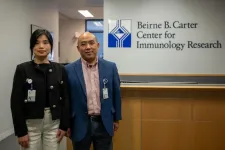(Press-News.org) ROCHESTER, Minnesota — Mayo Clinic researchers have found a new way to more precisely detect and monitor brain cell activity during deep brain stimulation, a common treatment for movement disorders such as Parkinson's disease and tremor. This precision may help doctors adjust electrode placement and stimulation in real time, providing better, more personalized care for patients receiving the surgical procedure. The study is published in the Journal of Neurophysiology.
Deep brain stimulation (DBS) involves implanting electrodes in the brain that emit electrical pulses to alleviate symptoms. The electrodes remain inside the brain connected to a battery implanted near the collarbone and controlled by a remote control. While a neurologist and neurosurgeon monitor the brain waves throughout the surgery, the monitoring typically is limited to a narrow frequency range that provides a rough snapshot of brain activity.
However, Mayo Clinic researchers used more sensitive, research-grade equipment and custom algorithms to record a broader frequency range of brain cell activity that yielded higher resolution and more precise information on when and where brain cells were firing in patients during DBS surgery.
"We looked at brain activity in a different way and recorded a type of brain signal called 'broadband' that reflects the combined activity across all frequencies and is related to the firing of all brain cells in that region. We found that the broadband activity signal increased with movement and was more precise in location than the standard, more narrow frequency signal," says lead author Bryan Klassen, M.D., a neurologist.
Dr. Klassen and colleagues detected the broadband signal in the motor thalamus, a region deep within the brain that controls movement. Previous studies have detected it only on the surface of the brain.
The researchers recorded broadband signals associated with hand movement in 15 patients undergoing awake DBS. Each of the patients were instructed to open and close their hands while the researchers recorded brain cell activity in their thalamus.
"This study enhances our understanding of how the thalamus, a brain region that is frequently targeted for deep brain stimulation, processes movement. It may lead to more precise mapping of the brain as well," says study coauthor Matthew Baker, Ph.D., a postdoctoral neurosurgery fellow at Mayo Clinic.
Using broadband to monitor during DBS surgery may improve the treatment and outcomes for patients.
"These findings underscore the remarkable advances we can achieve through the close collaboration between the neurology and neurosurgery departments and will help us develop the next generation of brain stimulation therapies," says neurosurgeon Kai Miller, M.D., Ph.D., the study’s senior author.
The next steps for this research involve further exploring how these brain activity patterns in the thalamus can be used to improve neurostimulation therapy, says Dr. Baker, a recent graduate of Mayo Clinic Graduate School of Biomedical Sciences.
"We will be investigating how this signal responds to different types of movements and whether we can use it to control new devices that only stimulate when patients need it, as opposed to constant stimulation, which is more prone to cause side effects," he says.
Review the study for a complete list of authors, disclosures and funding.
###
About Mayo Clinic
Mayo Clinic is a nonprofit organization committed to innovation in clinical practice, education and research, and providing compassion, expertise and answers to everyone who needs healing. Visit the Mayo Clinic News Network for additional Mayo Clinic news.
Media contact:
Alison Satake, Mayo Clinic Communications, newsbureau@mayo.edu
END
Thinking outside the box: Uncovering a novel approach to brainwave monitoring
2025-03-13
ELSE PRESS RELEASES FROM THIS DATE:
Combination immunotherapy before surgery may increase survival in people with head and neck cancer
2025-03-13
CHAPEL HILL, North Carolina—Researchers conducting a clinical trial of immunotherapy drugs for people with head and neck squamous cell carcinomas (HNSCCs) found that patients responded better to a combination of two immunotherapies than patients who received just one immunotherapy drug.
The scientists also analyzed immune cells in each person’s tumor after one month of immunotherapy to see which type of immune cells were activated to fight their cancer, suggesting that some of the cells and targets they identified could help individualize treatment benefit.
The findings appeared March 13, 2025 in Cancer Cell.
HNSCCs occur in the oral cavity, pharynx, hypopharynx, larynx, nasal ...
MIT engineers turn skin cells directly into neurons for cell therapy
2025-03-13
CAMBRIDGE, MA -- Converting one type of cell to another — for example, a skin cell to a neuron — can be done through a process that requires the skin cell to be induced into a “pluripotent” stem cell, then differentiated into a neuron. Researchers at MIT have now devised a simplified process that bypasses the stem cell stage, converting a skin cell directly into a neuron.
Working with mouse cells, the researchers developed a conversion method that is highly efficient and can produce more than 10 neurons from a single skin cell. If replicated in human ...
High sugar-sweetened beverage intake and oral cavity cancer in smoking and nonsmoking women
2025-03-13
About The Study: High sugar-sweetened beverage intake was associated with a significantly increased risk of oral cavity cancer in women, regardless of smoking or drinking habits, yet with low baseline risk in this study. Additional studies are needed in larger cohorts, including males, to validate the impact of these findings.
Corresponding Author: To contact the corresponding author, Brittany Barber, MD, MSc, email bbarber1@uw.edu.
To access the embargoed study: Visit our For The Media website at this link https://media.jamanetwork.com/
(doi:10.1001/jamaoto.2024.5252)
Editor’s ...
Area socioeconomic status, vaccination access, and female HPV vaccination
2025-03-13
About The Study: In this cross-sectional study of area deprivation, vaccination access, and human papillomavirus (HPV) vaccination status in Osaka City, Japan, higher socioeconomic status and higher medical facility access were associated with higher cumulative HPV vaccination uptake. These findings suggest that further strategies, including a socioecologic approach, are needed to increase HPV vaccination and reduce disparities in uptake.
Corresponding Author: To contact the corresponding ...
Checking PSA levels too soon after prostate cancer surgery can lead to overtreatment
2025-03-13
After surgical removal of the prostate to treat prostate cancer, clinicians monitor Prostate Specific Antigen (PSA) levels. Persistently elevated PSA levels indicate residual cancer and are linked to worse outcomes. But in a paper published in JAMA Oncology, Mass General Brigham researchers found that the current standard monitoring time of one-and-a-half to two months following surgery is too short to accurately identify recurrence and inform treatment decisions. Rather, PSA levels should be measured for at least three months to avoid overtreatment.
“Checking ...
CityUHK researchers develop an innovative bio-detection platform for cancer early screening and disease monitoring
2025-03-13
Cancer continues to be a leading cause of mortality worldwide, highlighting the urgent need to develop more advanced, efficient, and early detection methods. Addressing this critical need, City University of Hong Kong (CityUHK) is leading a groundbreaking research project aimed at developing an innovative technology platform for early detection of cancer and personalised treatment. The project aims specifically to enhance the detection of circulating tumor cells (CTCs), paving the way for significant advancements in cancer diagnosis and care. This is one of the first batch of projects that has secured funding by the RAISe+ Scheme.
The RAISe+ Scheme (the Research, ...
English translation of harnessing data for improved productivity: managing the full life cycle of data licensed at the London Book Fair
2025-03-13
On March 11, 2025, at the China Collective Stand of the London Book Fair, Tsinghua University Press (TUP) and the University of Toronto Press (UTP) sign a licensing agreement for the English version of Harnessing Data for Improved Productivity: Managing the Full Life Cycle of Data. This collaboration is a big step forward in putting China’s data management innovations on the global map, showcasing the nation’s cutting-edge achievements through leading ...
COVID-19 discovery opens door to new treatments for chronic lung problems
2025-03-13
University of Virginia School of Medicine scientists have discovered how severe COVID-19 can destroy immune cells’ ability to repair the lungs, helping explain the lingering effects of long COVID. The findings suggest a new treatment approach for long COVID as well as other conditions, both short-term and chronic, caused by respiratory infections such as the flu.
Led by UVA’s Jie Sun, PhD, the researchers found that severe viral infections including COVID-19 and the flu can gravely damage a key organelle inside immune cells called macrophages. Macrophages direct lung repair after tissue damage, but their ability to do so is crippled ...
Stanford Medicine research explores the promise and perils of AI in citizen science
2025-03-13
(Toronto, March 13, 2025) A new study published in JMIR Public Health and Surveillance by a team from Stanford Medicine investigates the potential of artificial intelligence (AI) to revolutionize citizen science and advance health equity. The study, titled “The Promise and Perils of Artificial Intelligence in Advancing Participatory Science and Health Equity in Public Health,” explores how AI technologies can empower communities to actively participate in scientific research and addresses critical ethical considerations.
This research, published by JMIR Publications, examines the potential of AI to significantly enhance citizen science by enabling more inclusive ...
New approaches to tackle coupled urban risks: a people-centric and complex systems perspective
2025-03-13
As urbanization surges and climate change intensifies, cities worldwide are facing an increasing number of coupled risks. A recent paper published in Engineering offers fresh insights into understanding and managing these risks.
The complexity of coupled risks in cities, which result from the compounded effects of interacting uncertainties across multiple interdependent objectives, is a major concern. A disruption in one urban subsystem can trigger a chain reaction, affecting other subsystems and leading to unforeseen consequences. For example, the extreme rainfall not only damaged infrastructure ...





